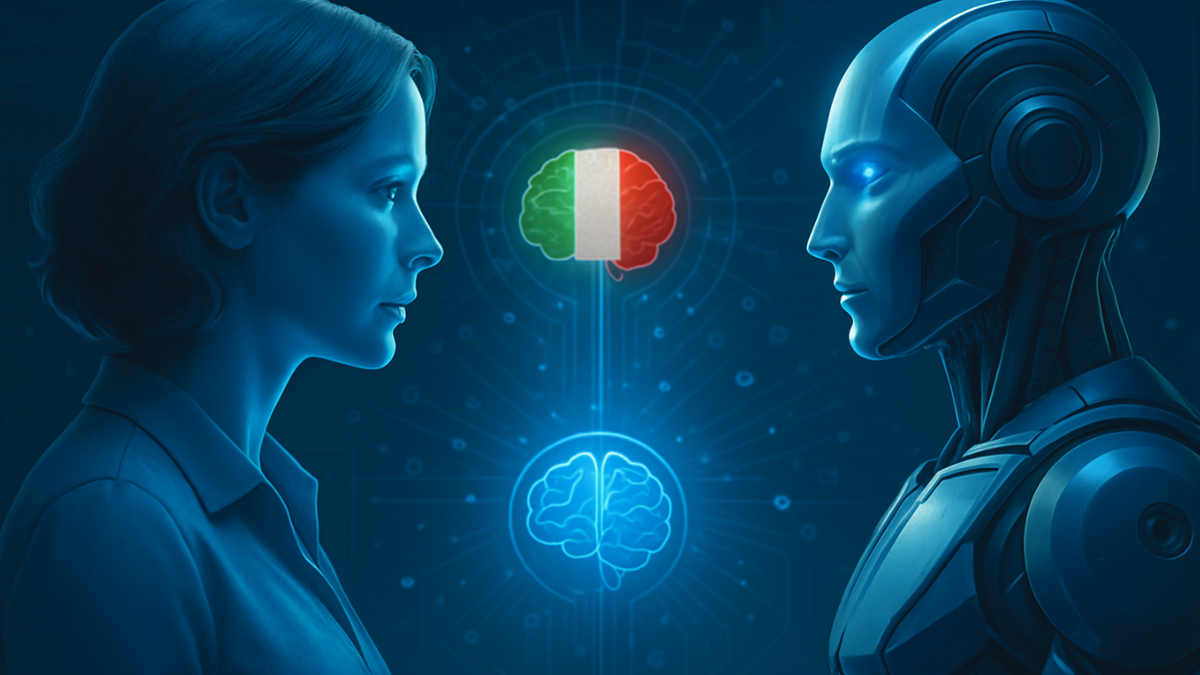Learn Italian with ChatGPT: Prompts, Voice Mode & Real-World Practice

Your complete guide to using AI to practice speaking, listening, reading, and writing in Italian—with fluency powered by the 3D Method™.
What You’ll Learn | Cosa imparerai
- Why ChatGPT can be a powerful ally — it’s always available for practice, but you’ll need to watch out for its blind spots.
- How AI can boost your writing — ChatGPT spots most errors in your Italian texts — great for drafts, but not flawless for polished work.
- The real magic of voice mode — with speaking practice and role-plays, ChatGPT feels almost like a private tutor on demand.
- Prompts are your superpower — the clearer your instructions, the better ChatGPT adapts to your level and goals.
- Why AI tutor apps often disappoint — most AI apps are generic and outdated, while ChatGPT allows open, personalized conversations.
- Using AI for all four skills — speaking, listening, reading, writing — ChatGPT can support them all if you combine the right exercises.
- The key to real fluency — AI is your practice space, but progress comes when you pair it with a structured method like the 3D Method™ inside 7-Week Italian®.
Oggi tutti parlano dell'intelligenza artificiale. Everyone is talking about AI — but can it really change how we learn Italian?
If you’re passionate about the language, you’ve probably asked yourself:
- Can ChatGPT really help me learn Italian faster?
- What’s the best way to use ChatGPT to practice Italian conversation?
- Is ChatGPT reliable for Italian grammar explanations?
Let’s dive into what ChatGPT and AI in general can (and can’t) do for your Italian
What is ChatGPT, and what does it have to do with learning Italian? | Che cos’è e cosa c’entra con l’italiano?
Artificial intelligence is a broad term for computer systems that can perform tasks we usually associate with human intelligence — understanding, reasoning, and generating language.
ChatGPT is one of these systems, designed specifically as a language model trained on massive amounts of text. Its job is to understand prompts and produce natural-sounding responses.
For language learners, the appeal is immediate: it’s always available, never gets tired, adapts to your requests, and provides a judgment‑free space where you can practice as much as you want.
But does that mean it can truly guide you?

Want to fast-track your Italian fluency and feel at home in Italy?
Become a priority reader for Italian You — the one book that will take your Italian to the next level.
🎁 Get “Italian You” with the Priority BonusIs ChatGPT reliable for Italian grammar explanations? | Posso usarlo per la grammatica?
ChatGPT has improved a lot in recent years, but it still shows clear limits when it comes to grammar.
When you ask about a specific rule, it usually gives a reasonable explanation. But it rarely corrects grammar accurately, and if it makes a mistake you often need to prompt it more than once before it adjusts. This is partly because most large language models were originally trained on English, with other languages added later.
So treat its grammar answers cautiously — sometimes they’re fine, but other times they need to be taken with a very large pinch of salt.
For example: Here’s how it might handle a sentence incorrectly — first the wrong version, then the corrected one, followed by common errors AI tends to make:
"Sono quarant'anni, anche, mia moglie" ("I am 40 years old, and so is my wife)."
ChatGPT might get many things wrong.
It actually just did as I tested it with this sentence I took form a student's assignment.
A human tutor would first of all make sure that what you want to communicate is your age and that of your wife, and suggest the simplest correct version:
"Ho quarant'anni, come mia moglie."
AI could leave 'sono' instead of suggesting the correct 'ho' (→ 'Ho quarant'anni…'), or it can even think you are talking about a period of time you've been married, and suggest to replace "Sono" with "Da". And if there is more than one thing to correct, the less common mistakes might get overlooked.
ChatGPT can often provide useful clarifications, but it also:
- makes basic mistakes,
- explains concepts in ways that only make sense if you already know the rule,
- and occasionally oversimplifies complex topics, or make incorrect assumptions.
- It also tends to lean on English logic, producing literal translations or “false friends”.
👉 Use it for clarifications, but not as your main grammar teacher or as the final check on assignments. Always cross‑check with a reliable source or structured program.
The good news: when you use it for general Italian conversation or non‑technical topics, it makes far fewer mistakes and can provide excellent practice — if you guide it with clear prompts.

Want to fast-track your Italian fluency and feel at home in Italy?
Become a priority reader for Italian You — the one book that will take your Italian to the next level.
🎁 Get “Italian You” with the Priority BonusCan ChatGPT help me improve my Italian writing? | Può aiutarmi a migliorare la scrittura?
ChatGPT is fairly strong at correcting written Italian, but it still isn’t flawless. In recent tests with real student work, it identified around 75–95% of errors — a clear improvement from only a few years ago, when it hovered closer to 70%. Progress is visible, but it still misses some mistakes, even if it rarely invents corrections where none are needed.
👉 Use it to check your Italian journal entries, emails, or practice essays. It’s useful for spotting obvious errors and cleaning up drafts, but don’t count on it for perfectly polished homework or formal writing.
And remember, everything you write in Italian, you should first write by hand!

What’s the best way to practice speaking Italian with ChatGPT? | Qual è il modo migliore per far pratica con ChatGPT?
That's where true magic begins!
One of the most exciting features introduced recently is ChatGPT’s voice mode. It’s a game-changer because it lets you practice real conversation out loud — almost like having a private tutor on demand.
Here’s how to set it up for success:
1. Start by setting the rules (you can do this in English)
To avoid confusion, give your instructions in English at the start, for example:
"We are going to practice Italian conversation. Please reply only in Italian. Keep your answers short, and adjust to my level. I am currently an advanced beginner. If I ask you to repeat, repeat the exact same phrase slowly. If I still don't understand, rephrase it in simpler Italian. When I make mistakes, point them out before answering."
Then switch to Italian and begin speaking.
2. Control the speed and complexity
During the chat, you can fine-tune things with simple requests:
- “Puoi parlare più lentamente?” — Can you speak more slowly?
- “Per favore, usa frasi più semplici.” — Please use simpler sentences.
- “Puoi ripetere la frase più lentamente?” — Can you repeat the sentence more slowly?
- “Puoi dire la stessa cosa in parole più semplici?” — Can you say the same thing in simpler words?
- “Puoi spiegare il significato di ‘_____’?” — Can you explain this word?
- “Puoi tradurre questa frase in inglese?” — Can you translate this sentence into English?
3. Role-play useful everyday situations
To make practice realistic, ask ChatGPT to act out common contexts:
- “Tu sei il cameriere, io sono il cliente.” — You’re the waiter, I’m the customer.
- “Puoi dirmi come arrivare al duomo?” — Can you tell me how to get to the cathedral?
- “Sto entrando in un hotel, tu sei alla reception.” — I’m checking into a hotel, you’re at the reception desk.
- “Vorrei vedere una casa che sto pensando di comprare.” — I’d like to see a house I’m considering buying.
- “Siamo al ristorante, consigliami cosa ordinare.” — We’re at a restaurant, recommend me what to order.
👉 Practicing this way strengthens your speaking, listening, and confidence all at once.
And remember: the real magic isn’t just in speaking — it’s in the prompts. With the right ones, you can make ChatGPT adapt to your level, your pace, and even your interests.
What are the best prompts for practicing Italian with ChatGPT? | Quali sono i prompt migliori?
Here are categories of prompts you can use, depending on your goals and level:
Conversation Starters
- Parliamo in italiano di viaggi. — Let’s talk in Italian about travel.
- Fammi domande come se fossi un nuovo amico italiano. — Ask me questions as if you were a new Italian friend.
Tutor’s Correction Prompts
Here you can decide how and when ChatGPT should correct you:
- Correggi i miei errori solo alla fine della conversazione. — Correct my mistakes only at the end of the conversation.
- Correggi i miei errori dopo ogni frase, ma continua la conversazione. — Correct my mistakes after each sentence, but keep the conversation going.
- Segnala solo gli errori più gravi e lascia passare i piccoli sbagli. — Point out only serious mistakes and let the small ones pass.
- Riscrivimi la frase corretta e spiegami la differenza in inglese. — Rewrite the correct sentence and explain the difference in English.
- Ripeti la mia frase corretta lentamente così posso imitarla. — Repeat my corrected sentence slowly so I can imitate it.
Vocabulary Building Prompts
- Dammi 10 parole utili sul tema del viaggio con frasi di esempio. — Give me 10 useful travel words with example sentences.
- Insegnami le espressioni più comuni usate in un hotel. — Teach me the most common expressions used in a hotel.
Cultural and Curiosity Prompts
- Raccontami la storia del Colosseo in italiano semplice. — Tell me the story of the Colosseum in simple Italian.
- Quali sono le feste più importanti in Italia? — What are the most important holidays in Italy?
- Parlami di Leonardo da Vinci in modo semplice. — Tell me about Leonardo da Vinci in simple Italian.
- Spiegami le differenze tra le cucine regionali italiane. — Explain the differences between regional Italian cuisines.
- Descrivi una tradizione tipica di Natale in Italia. — Describe a typical Christmas tradition in Italy.
- Parliamo delle città toscane meno conosciute che meritano una visita. — Let’s talk about lesser-known Tuscan towns worth visiting.
👉 Mix and match these prompts, adapt them to your interests, and don’t hesitate to tell ChatGPT exactly how you’d like it to respond. That’s how you’ll get practice that feels personal and effective.

Want to fast-track your Italian fluency and feel at home in Italy?
Become a priority reader for Italian You — the one book that will take your Italian to the next level.
🎁 Get “Italian You” with the Priority BonusAre AI tutor apps good for learning Italian? | Le app di tutoraggio con IA sono una buona scelta?
Many so-called AI tutor apps promise instant conversation skills with automated speaking partners. But when you look closely, they come with serious limitations:
- Outdated and generic: most cover dozens of languages at once (23 seems to be the standard number), which means none of them are truly polished or highly specialized for Italian.
- Trained through English: they often rely on word-for-word translation from English, leading to awkward or incorrect Italian phrasing. And you can catch those "calques" even in their ads, that are supposed to be the most polished example of what they can do.
- Defect-prone: speech recognition can misinterpret what you say, and rarely gives you proper pronunciation feedback.
- Gamified over guided: streaks, points, and badges keep you entertained, but they don’t guarantee progress or provide true accountability.
- Rarely updated: once created, they’re seldom improved. Mistakes and imperfections remain, and quality never really advances. There is no real incentive for them to do that, among other reasons, because their customers rarely have the tools to tell how bad the quality is.
ChatGPT, on the other hand, lets you:
- Personalize your practice with rules and prompts that match your level and needs.
- Go beyond scripts into open conversations on any topic, as deep as you like.
- Stay current! Because ChatGPT is constantly updated and can integrate cultural and linguistic nuances much better than static apps.
👉 In short: AI tutor apps can seem appealing, but the investment is rarely justified. Their updates aren’t guaranteed, their quality is inconsistent, and they take control of your learning process without providing you with all the elements for success.
ChatGPT — with all its imperfections — is by far the better alternative at the moment.

How can I use ChatGPT to improve all my Italian language skills? | Come usare ChatGPT per migliorare le mie abilità linguistiche?
ChatGPT is not just about reading and writing anymore. With voice mode and the right prompts, it can now support all four language skills — speaking, listening, reading, and writing. The trick is knowing how to combine them:
- Write and then read everything out loud → strengthens both reading and speaking.
- Use voice mode or pair with text-to-speech → builds listening comprehension.
- Ask it to dictate sentences for you to transcribe → trains listening + writing.
- Summarize or retell a conversation in your own words → sharpens grammar intuition and fluency.
Want to practice listening? Paste an Italian text into ChatGPT, ask it to read it back to you,
and then turn it into a dictation exercise.
👉 ChatGPT isn’t a perfect tool for learning Italian, but it’s an extraordinary tool for practicing it. Just a few years ago this would have sounded like science fiction — now it’s reality. If you follow a few simple rules, ChatGPT can become a powerful ally to support your daily practice and build fluency.
Final tips for using ChatGPT to learn Italian
Never share personal information or any sensitive data in your chats.
Don’t rely 100% on ChatGPT for grammar or corrections. Always double-check with trusted resources.
Use a dictionary and structured learning program alongside ChatGPT to anchor your progress.
Set clear rules before starting practice — for example, when you want corrections, how long answers should be, or which topics to focus on.
Use ChatGPT to practice, not to learn — think of it as your rehearsal space. It’s excellent for reinforcing what you already know, testing your skills, and building fluency through repetition. But it’s not designed to guide your progress or introduce new concepts — for that, you still need a structured program or teacher.
ChatGPT is an exciting tool for learners and will continue to improve.
But remember — it’s just a tool. It will never replace a teacher, a community, or a holistic method.
👉 If you want Italian to truly become part of you, combine ChatGPT practice with a structured approach like the 3D Method™ inside Italian You and the 7-Week Italian® Campus.
That’s where AI meets real transformation.

About the Author
Tania Troyan is the founder of 7-Week Italian® and the author of the book How to Unlock Your Learning Potential, Master Italian, and Feel at Home in Italy. She’s on a mission to change the way adults learn Italian—replacing outdated methods with a holistic, neuroscience-based approach grounded in linguistic and cultural transformation.
Through her 3D Method™ and with the support of her dedicated team of native Italian teachers, she has helped thousands of English speakers build fluency and shape their new Italian identity. She believes learning Italian should be a transformative and empowering journey—for mind, heart, and voice— a journey toward your Italian Self.
Learning Italian with ChatGPT FAQs | Domande e risposte ❓
Can ChatGPT really help me learn Italian fluently?
Yes, but not on its own. ChatGPT is great for practice — conversation, writing, listening — but it still makes grammar mistakes. Use it as a rehearsal tool, not your main teacher.
Is ChatGPT reliable for Italian grammar explanations?
Only partly. It explains rules fairly well but often misses corrections or applies English logic. Always double-check with reliable resources or a structured program.
What’s the best way to practice speaking with ChatGPT?
Use voice mode with clear prompts. Ask it to slow down, simplify phrases, or role-play real-life situations like ordering in a restaurant or checking into a hotel.
Can ChatGPT improve all my Italian skills?
Yes — if you combine the right exercises. Use it to practice speaking, listening, reading, and writing, but remember: true fluency comes when AI practice is paired with a method like the 3D Method™ inside 7-Week Italian®.
Italian You — learn Italian and feel at home in Italy, faster 🍋
Want to fast-track your Italian fluency and become part of the Italian culture? Become a priority reader of Italian You — the book that helps you not just learn, but speak, think, and become more Italian.
- Avoid the pitfalls of outdated learning methods.
- Create an immersive Italian Ecosystem that makes fluency feel effortless.
- Master grammar, vocabulary, and pronunciation naturally.
- Stay motivated and committed to your learning journey.
💡 When you join the Priority Readers List, you also get a special bonus: 100% off on the Ultimate Italian-English Cognates Blueprint 🎁

Categories: : Digital tools
 Tania Troyan
Tania Troyan 